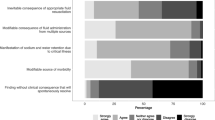Abstract
The objective of the study was to evaluate intravenous microdialysis for monitoring of plasma lactate, pyruvate, glucose, creatinine, urea, adenosine, inosine and hypoxanthine in intensive care patients. Microdialysis probes (O. D. 0.9 mm; membrane length 20 mm) were inserted into major veins and perfused with Ringer's solution. Dialysis samples were collected from 4 patients with septic shock in 60 min fractions during 24 h. At the end of every hour a venous blood plasma sample was drawn from the corresponding contralateral vein for comparison. Microdialysate values of all metabolites closely followed the changes in the corresponding blood samples. The in vivo recovery of the probe type used was close to 100% for lactate, creatinine, and urea, and about 90% for glucose. It is concluded that intravenous microdialysis sampling is a suitable method for continuous bedside monitoring of important metabolites in intensive care patients.
Similar content being viewed by others
References
Weil MH, Afifi AA (1970) Experimental and clinical studies on lactate and pyruvate as indicators of the severity of acute circulatory failure (shock). Circulation 41:989–1001
Winkel P, Afifi A, Caddy L, Weil M, Shubin H (1971) Application of statistical techniques for assessment of prognosis in patients with acute circulatory failure (shock). J Chronic Dis 24:61–69
Vitek V, Cowley R (1971) Blood lactate in the prognosis of various forms of shock. Ann Surg 173:308–313
Caddy LD, Weil MH, Afifi AA et al (1973) Quantitation of severity of critical illness with special reference to blood lactate. Crit Care Med 1:75
Nast-Kolb D, Waydhas C, Jochum M, Duswald K, Machleidt W, Spannagl M, Schram W, Fritz H, Schweiberer L (1992) Biochemische Faktoren als objektive Parameter zur Prognoseabschätzung beim Polytrauma. Unfallchirurg 95:59–66
Mizock BA, Falk JL (1992) Lactic acidosis in critical illness. Crit Care Med 20:80–93
Azimi G, Vincent J (1986) Ultimate survival from septic shock. Resuscitation 14:245–253
Pasch T, Mahlstedt J, Pichl J, Buheitel G, Pscheidl E (1987) Can the outcome after trauma or sepsis be predicted from biochemical or hormonal parameters? Prog Clin Biol Res 236B:85–95
Saugstad OD (1975) Hypoxanthine as a measurement of hypoxia. Pediatr Res 9:158–161
Shinzato T, Nakai S, Odani H, Nakane K, Takai I, Maeda K (1992) Relationship between dialysis induced hypotension and adenosine released by ischemic tissue. ASAIO J 38:M286–290
Meyerson B, Linderoth B, Karlsson H (1990) Microdialysis, in the human brain; extracellular measurements in the thalamus of parkinsonian patients. Life Sci 46:301–308
Hillered L, Persson L, Pontén U, Ungerstedt U (1990) Neurometabolic monitoring of the ischemic brain using microdialysis. Acta Neurochir 102:91–97
Persson L, Hillered L (1992) Chemical monitoring of neurosurgical intensive care patients using intracerebral microdialysis. J Neurosurg 76:72–80
Carlson H, Ronne-Engström E, Ungerstedt U, Spännare B, Hillered L (1992) Seizure related elevations of extracellular amino acids in human focal epilepsy. Neurosci Lett 140:30–32
Lönnroth P, Jansson P, Smith U (1987) A microdialysis method allowing characterization of intracellular water space in humans. Am J Physiol 253:E228–231
Bolinder J, Hagström E, Ungerstedt U, Arner P (1989) Microdialysis of subcutaneous adipose tissue in vivo for continuous glucose monitoring in man. Scand J Clin Lab Invest 49:465–474
Hickner R, Rosdahl H, Borg I, Ungerstedt U, Jorfeldt L, Henriksson J (1991) Ethanol may be used with the microdialysis technique to monitor blood flow changes in skeletal muscle; dialysate glucose concentration is blood flow dependent. Acta Physiol Scand 143:355–356
Hallström Å, Carlsson A, Hillered L et al (1989) Simultaneous determination of lactate, pyruvate, and ascorbate in microdialysis samples from rat brain, blood, fat, and muscle using high-performance liquid chromatography. J Pharmacol Methods 22:113–124
Fredholm B, Sollevi A (1981) The release of adenosine and inosine from canine subcutaneous adipose tissue by nerve stimulation and noradrenaline. J Physiol (Lond) 313:351–367
Meyerhoff C, Bischof F, Sternberg F, Zier H, Pfeiffer EF (1992) On line continuous monitoring of subcutaneous tissue glucose in men by combining portable glucosensor with microdialysis. Diabetologia 35:1087–1092
Lindefors N, Amberg G, Ungerstedt U (1989) Intracerebral microdialysis: I. Experimental studies of diffusion kinetics. J Pharmacol Methods 22:141–156
Benveniste H (1989) Brain microdialysis. J Neurochem 52:1667–1679
Harkness R, Simmonds R, Coade S (1983) Purine transport and metabolism in man: the effect of exercise on concentrations of purine bases, nucleosides and nucleotides in plasma, urine, leucocytes and erythrocytes. Clin Sci 64:333–340
Author information
Authors and Affiliations
Rights and permissions
About this article
Cite this article
Stjernström, H., Karlsson, T., Ungerstedt, U. et al. Chemical monitoring of intensive care patients using intravenous microdialysis. Intensive Care Med 19, 423–428 (1993). https://doi.org/10.1007/BF01724886
Received:
Accepted:
Issue Date:
DOI: https://doi.org/10.1007/BF01724886




